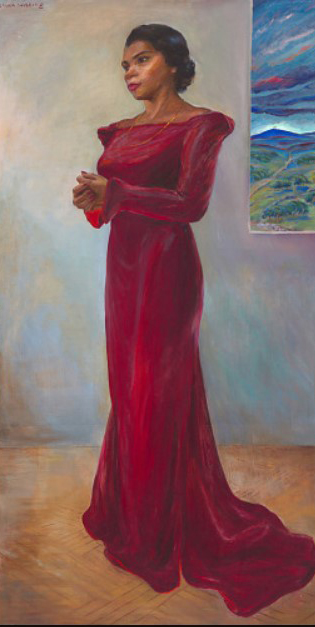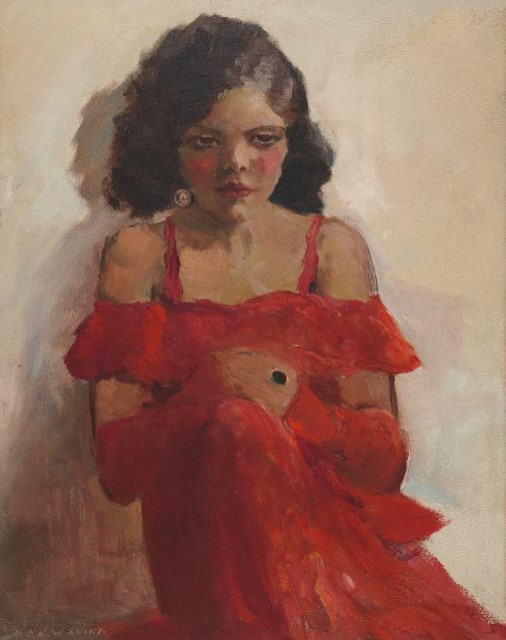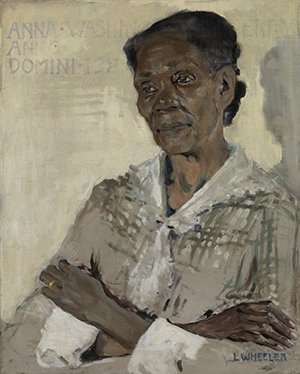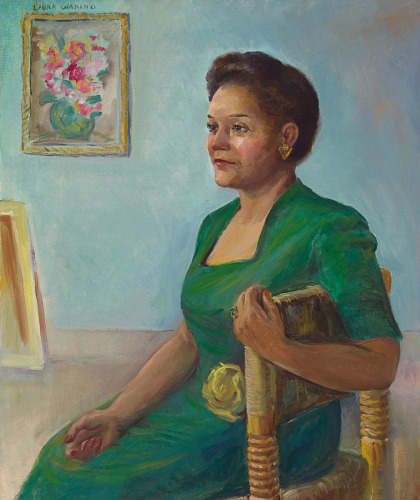Laura Wheeler Waring: A Luminous Palette
by Cherene Sherrard-Johnson
 In Laura Wheeler Waring’s Portrait of Marian Anderson (1944), you can almost hear the renowned contralto’s voice soaring in the pastel room in which she stands. There is a vitality to this painting that evokes the performer behind the façade. Strikingly, Wheeler Waring does not position Anderson on a stage, which is where she first heard Anderson sing. She paints her alone in a room with a single window that frames a bucolic pasture and skyscape, combining two features, portraiture and landscape. Wheeler Waring’s iconic image of Anderson recalls the grace and dignity that Anderson brought to her concert on the steps of the Lincoln Memorial after the Daughters of the American Revolution refused to allow her to perform in Constitution Hall in 1939. Anderson would go on to have a groundbreaking musical career. Wheeler Waring captures her contemplative subject in a moment of self-gathering before or after she opens her mouth to sing.
In Laura Wheeler Waring’s Portrait of Marian Anderson (1944), you can almost hear the renowned contralto’s voice soaring in the pastel room in which she stands. There is a vitality to this painting that evokes the performer behind the façade. Strikingly, Wheeler Waring does not position Anderson on a stage, which is where she first heard Anderson sing. She paints her alone in a room with a single window that frames a bucolic pasture and skyscape, combining two features, portraiture and landscape. Wheeler Waring’s iconic image of Anderson recalls the grace and dignity that Anderson brought to her concert on the steps of the Lincoln Memorial after the Daughters of the American Revolution refused to allow her to perform in Constitution Hall in 1939. Anderson would go on to have a groundbreaking musical career. Wheeler Waring captures her contemplative subject in a moment of self-gathering before or after she opens her mouth to sing.
Born in Hartford, Connecticut, in 1887, Wheeler Waring imagined a career as a painter from a young age. Despite the challenges of gender discrimination and racial segregation, she was undaunted in her path, attending the Pennsylvania Academy (1918–1924) and later traveling to Paris, where she honed her craft at the Académie de La Grande Chaumière (1914–1917, 1924–1925). The number of her original paintings was impressive, but her credited and anonymous illustrations in prominent journals like the NAACP’s publication The Crisis reached an even larger audience. Wheeler Waring would go on to teach art at the Cheyney Training School for Teachers in Philadelphia. She was one of the only early Black female painters to have a solo exhibition of her paintings in France and in prominent institutions like the Philadelphia Museum of Art and the Art Institute of Chicago. Wheeler Waring died in Philadelphia in 1948.
 Two portraits exemplify Wheeler Waring’s commitment to complex renditions of everyday Black female subjects as well as famous ones. The first is Girl in a Red Dress (1935). Painted in France of an unknown subject, this image captures the vulnerability and daring of a girl on the cusp of womanhood. The scarlet blush of her cheeks accents the red of the dress, but it’s the bare shoulders and revealing neckline, despite the absence of mature décolletage, that suggest she might be a Parisian showgirl reminiscent of post-impressionist painter Henri de Toulouse-Lautrec’s lurid, but vibrant and enticing, scenes from the Folies Bergère and Moulin Rouge. Although seated with legs unseen and primly tucked outside the frame, Girl is dressed for a night out dancing. One can almost imagine the swish of her modern bob. Perhaps Waring caught her enigmatic subject resting between dancing partners? Girl’s sullen expression contradicts the revealing ruffles, and there’s an excess of skin and adornments like the oval black ring oriented diagonally from her single, round, gold earring. This image recalls a scene from Harlem Renaissance writer Nella Larsen’s novel Quicksand (1929), wherein a Harlem socialite disapproves of mixed-race protagonist Helga Crane’s dress as “too décolleté, and too outré” for a soirée, ultimately declaring that, “There’s not enough of it, and what there is gives you the air of something about to fly” (56). Helga wears the dress anyway, but shortly after abandons Harlem for Copenhagen. Much of Harlem Renaissance art and literature was marked by an inter-artistic aesthetic that manifested in cross-genre collaborations appearing in periodicals, as cover art, or via visual storytelling done with the paintbrush.
Two portraits exemplify Wheeler Waring’s commitment to complex renditions of everyday Black female subjects as well as famous ones. The first is Girl in a Red Dress (1935). Painted in France of an unknown subject, this image captures the vulnerability and daring of a girl on the cusp of womanhood. The scarlet blush of her cheeks accents the red of the dress, but it’s the bare shoulders and revealing neckline, despite the absence of mature décolletage, that suggest she might be a Parisian showgirl reminiscent of post-impressionist painter Henri de Toulouse-Lautrec’s lurid, but vibrant and enticing, scenes from the Folies Bergère and Moulin Rouge. Although seated with legs unseen and primly tucked outside the frame, Girl is dressed for a night out dancing. One can almost imagine the swish of her modern bob. Perhaps Waring caught her enigmatic subject resting between dancing partners? Girl’s sullen expression contradicts the revealing ruffles, and there’s an excess of skin and adornments like the oval black ring oriented diagonally from her single, round, gold earring. This image recalls a scene from Harlem Renaissance writer Nella Larsen’s novel Quicksand (1929), wherein a Harlem socialite disapproves of mixed-race protagonist Helga Crane’s dress as “too décolleté, and too outré” for a soirée, ultimately declaring that, “There’s not enough of it, and what there is gives you the air of something about to fly” (56). Helga wears the dress anyway, but shortly after abandons Harlem for Copenhagen. Much of Harlem Renaissance art and literature was marked by an inter-artistic aesthetic that manifested in cross-genre collaborations appearing in periodicals, as cover art, or via visual storytelling done with the paintbrush.
 The Harmon Foundation Gold Medal–winning painting of Anna Washington Derry (1927) is on the opposite end of the spectrum from Girl. Wheeler Waring devoted sustained attention to the face of an elder Black woman, a subject frequently either overlooked or denigrated in early twentieth-century American visual culture. Instead of choosing a vivid primary color for the subject’s clothing as was her typical practice, Wheeler Waring paints Derry in a white dress with a pattern that seems to be almost an afterthought, so that nothing distracts or detracts viewers from the strong lines of her cheekbones, the dark brown lowlights in her skin, the somewhat melancholy expression, gentle eyes, crossed arms, and delicately distinguished fingernails. Anna Derry is not a famous singer or a public intellectual, but her image holds one’s attention just the same.
The Harmon Foundation Gold Medal–winning painting of Anna Washington Derry (1927) is on the opposite end of the spectrum from Girl. Wheeler Waring devoted sustained attention to the face of an elder Black woman, a subject frequently either overlooked or denigrated in early twentieth-century American visual culture. Instead of choosing a vivid primary color for the subject’s clothing as was her typical practice, Wheeler Waring paints Derry in a white dress with a pattern that seems to be almost an afterthought, so that nothing distracts or detracts viewers from the strong lines of her cheekbones, the dark brown lowlights in her skin, the somewhat melancholy expression, gentle eyes, crossed arms, and delicately distinguished fingernails. Anna Derry is not a famous singer or a public intellectual, but her image holds one’s attention just the same.
Wheeler Waring’s demonstrated expertise at portraiture should not overshadow her ability to communicate kinetic movement as she does in Jazz Dancer I (1939). This painting centers a stylish, dancing couple whose movements are amplified by white lines radiating across the floor. The dancehall’s décor features walls with abstract swirls of geometric shapes and colors. The subjects’ attire playfully stretches gender roles. The woman wears an audacious white pantsuit with bell-bottom legs and beribboned kitten heels, while her partner is every inch the dandy in shiny black top hat and tails. As art historian Lisa Farrington observes, “Waring’s portrayal also epitomizes the look of the New Negro—attractive, cosmopolitan, and fashionable” in contradistinction to grotesque postures and negative stereotyping widespread in commercial media of the day (82).
Wheeler Waring’s illustrations were often the result of collaborations with writers. She illustrated several of the fables and nursery rhymes in The Brownies Book (1920–1921)—the first Black children’s publication. After she encountered novelist, editor, and poet Jessie Redmon Fauset in Paris, the two would later travel to Algeria. Wheeler Waring penned the illustrations for Fauset’s two-part travelogue about gender, race, and colonialism in Algeria entitled “Dark Algiers the White,” which was published in the NAACP’s Crisis magazine in 1925. Wheeler Waring’s drawings of the alleyways of the Casbah visualize the cross-cultural encounters Fauset has with native informants as she ventures beyond the veil to share the experiences of international women of color with the Crisis’ readership.
 While Wheeler Waring’s paintings are notable for the rich and varied brown palette she used to depict Black subjects of all ages with dignity and detail, she was particularly fond of red and utilized a spectrum of crimson shades for the attire in Marian Anderson, Portrait of a Lady (1947), After Sunday Service (1940), and the aforementioned Girl in the Red Dress. As part of a commission from the Harlem Foundation, Wheeler Waring also painted realistic portraits of many of the New Negro era’s most prominent figures, including intellectual W. E. B. Du Bois, Jessie Redmon Fauset, and composer/writer James Weldon Johnson. Several of these portraits now hang in the National Portrait Gallery. In this way Wheeler Waring is a precursor of celebrated twenty-first-century Black portrait painters like Amy Sherald and Kehinde Wiley, who painted the presidential portraits of First Lady Michelle Obama and President Barack Obama, respectively. We can see evidence of Wheeler Waring’s blend of realist and modernist aesthetics in Sherald’s preference for darker-hued skin tones and in Wiley’s florid textile and botanical backdrops. A study of Wheeler Waring’s enduring artistic legacy reveals the evolution of Black portraiture in American art.
While Wheeler Waring’s paintings are notable for the rich and varied brown palette she used to depict Black subjects of all ages with dignity and detail, she was particularly fond of red and utilized a spectrum of crimson shades for the attire in Marian Anderson, Portrait of a Lady (1947), After Sunday Service (1940), and the aforementioned Girl in the Red Dress. As part of a commission from the Harlem Foundation, Wheeler Waring also painted realistic portraits of many of the New Negro era’s most prominent figures, including intellectual W. E. B. Du Bois, Jessie Redmon Fauset, and composer/writer James Weldon Johnson. Several of these portraits now hang in the National Portrait Gallery. In this way Wheeler Waring is a precursor of celebrated twenty-first-century Black portrait painters like Amy Sherald and Kehinde Wiley, who painted the presidential portraits of First Lady Michelle Obama and President Barack Obama, respectively. We can see evidence of Wheeler Waring’s blend of realist and modernist aesthetics in Sherald’s preference for darker-hued skin tones and in Wiley’s florid textile and botanical backdrops. A study of Wheeler Waring’s enduring artistic legacy reveals the evolution of Black portraiture in American art.
Further reading
Farrington, Lisa E. Creating Their Own Image: The History of African-American Women Artists. Oxford: Oxford University Press, 2005.
Kirschke, Amy Helene. “Laura Wheeler Waring and the Women Illustrators of the Harlem Renaissance,” in Women Artists of the Harlem Renaissance, ed. Amy Helene Kirschke. Jackson: University of Mississippi Press, 2014.
Larsen, Nella. Quicksand. New York: Knopf, 1928.
Sherrard-Johnson, Cherene. “Illustrating, Publishing, and the Female Artists of the Harlem Renaissance,” in Imprinted: Illustrating Race. Norman Rockwell Museum, 2022.
Cherene Sherrard-Johnson is the E. Wilson Lyon Professor of the Humanities and chair of the English Department at Pomona College. She is the author of Portraits of the New Negro Woman: Visual and Literary Culture in the Harlem Renaissance (Rutgers University Press, 2007), Dorothy West’s Paradise: A Biography of Class and Color (Rutgers University Press, 2012), and two poetry collections, Vixen (Autumn House Press, 2017) and Grimoire (Autumn House Press, 2020). She is the editor of a critical edition of Jessie Redmon Fauset’s Comedy: American Style (Rutgers University Press, 2009), A Companion to the Harlem Renaissance (Wiley, 2015), and The Cambridge Companion to the Black Body in American Literature (Cambridge University Press, 2024).









































































